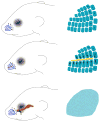Development and critical period plasticity of the barrel cortex
- PMID: 22607000
- PMCID: PMC3359866
- DOI: 10.1111/j.1460-9568.2012.08075.x
Development and critical period plasticity of the barrel cortex
Abstract
In primary sensory neocortical areas of mammals, the distribution of sensory receptors is mapped with topographic precision and amplification in proportion to the peripheral receptor density. The visual, somatosensory and auditory cortical maps are established during a critical period in development. Throughout this window in time, the developing cortical maps are vulnerable to deleterious effects of sense organ damage or sensory deprivation. The rodent barrel cortex offers an invaluable model system with which to investigate the mechanisms underlying the formation of topographic maps and their plasticity during development. Five rows of mystacial vibrissa (whisker) follicles on the snout and an array of sinus hairs are represented by layer IV neural modules ('barrels') and thalamocortical axon terminals in the primary somatosensory cortex. Perinatal damage to the whiskers or the sensory nerve innervating them irreversibly alters the structural organization of the barrels. Earlier studies emphasized the role of the sensory periphery in dictating whisker-specific brain maps and patterns. Recent advances in molecular genetics and analyses of genetically altered mice allow new insights into neural pattern formation in the neocortex and the mechanisms underlying critical period plasticity. Here, we review the development and patterning of the barrel cortex and the critical period plasticity.
© 2012 The Authors. European Journal of Neuroscience © 2012 Federation of European Neuroscience Societies and Blackwell Publishing Ltd.
Conflict of interest statement
The authors declare that they have no competing interests.
Figures


References
-
- Abdel-Majid RM, Leong WL, Schalkwyk LC, Smallman DS, Wong ST, Storm DR, Fine A, Dobson MJ, Guernsey DL, Neumann PE. Loss of adenylyl cyclase I activity disrupts patterning of mouse somatosensory cortex. Nat Genet. 1998;19:289–291. - PubMed
-
- Angevine JB, Sidman RL. Autoradiographic study of cell migration during histogenesis of cerebral cortex in the mouse. Nature. 1961;192:766–768. - PubMed
Publication types
MeSH terms
Grants and funding
LinkOut - more resources
Full Text Sources

